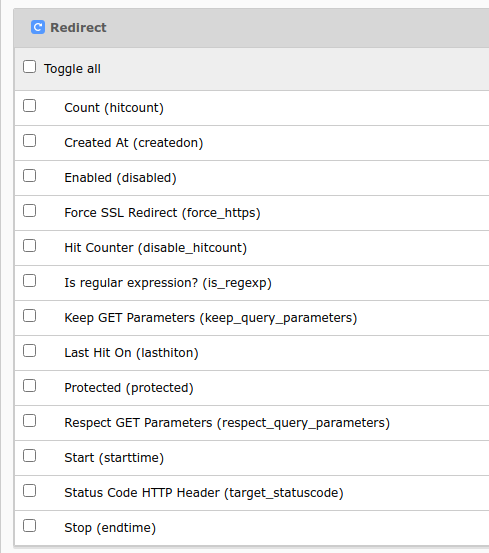Setup¶
The redirects extension requires no extra configuration once it is installed. However, it is recommended to familiarize yourself with the settings and commands outlined in this page. Depending on your site and how editing is handled, changes in the configuration and regular maintenance may be required.
Site configuration¶
The core comes with the following site settings for redirects which can be
adjusted in the file config/sites/<site>/config.yaml for
each site.
Hint
In non Composer installations, the file is found in
typo3conf/sites/<site>/config.yaml.
The following settings apply to automatically created redirects.
TYPO3 comes with working defaults. It is not necessary to add the settings section if you use the defaults.
settings:
redirects:
# Automatically update slugs of all sub pages
# (default: true)
autoUpdateSlugs: true
# Automatically create redirects for pages with a new slug (works only in LIVE workspace)
# (default: true)
autoCreateRedirects: true
# Time To Live in days for redirect records to be created - `0` disables TTL, no expiration
# (default: 0)
redirectTTL: 0
# HTTP status code for automatically created redirects, see
# https://developer.mozilla.org/en-US/docs/Web/HTTP/Redirections#Temporary_redirections
# (default: 307)
httpStatusCode: 307
The httpStatusCode does not affect the default status code for manually created
redirects. This can be adjusted via TCA
$GLOBALS['TCA']['sys_redirect']['columms']['config']['target_statuscode']['default].
See also
The settings in the site configuration are generally explained in
"TYPO3 Explained" > Site Settings.
Console commands¶
As for commands in general, it is possible to execute them via the command line or via the TYPO3 scheduler in the backend. Please see the general information about this in "TYPO3 Explained" > Running the Command From the Command Line.
We explain executing the commands from the command line here, it is recommended to automate regular execution, e.g. via cron.
redirects:checkintegrity¶
The checkintegrity command checks existing redirects for conflicts. A typical
conflict may be a redirect loop. In this case the source
and target point to the same page or the redirect loop affects a number of
redirects, each redirecting to the next and looping back to the first, e.g.
/a => b, /b => /a.
Warning
Currently, there are known problems where the checkintegrity command may report false positives. This can happen if additional routing enhancers / decorators are in place.
Example usage to check all sites:
vendor/bin/typo3 redirects:checkintegrity
Check only the site mysite:
vendor/bin/typo3 redirects:checkintegrity mysite
This will output one line per redirect conflict. The output may look like this:
Redirect (Host: *, Path: /test-1) conflicts with http://mysite/test-1
You can now search for the affected redirects in the redirects module, e.g.
by filtering with Source Path /test-1.
Configure editor permission¶
By default, editors (without admin privileges) cannot access redirects directly and they cannot revert automatic redirects. This can be problematic, because the notification with the option to revert redirects and the notification that they were reverted appears regardless, even if an editor does not have access and the redirects are not reverted.
In order to make reverting redirects possible for non-admin backend users, configure this in the backend group Access Lists tab:
Activate Redirect [sys_redirect] in Tables (listing)
Activate Redirect [sys_redirect] in Tables (modify)
In order to give editors full access to the redirects module, give them
access to the sys_redirect table as outlined above and configure this in
the backend group Access Lists tab:
Activate Site Management>Redirects [site_redirects] in Modules.
Warning
It is recommended to only give trusted and experienced backend users access to the redirects module because they will have access to all redirects for the entire installation and may unintentionally wreak havoc on the site.
Especially problematic can be redirect loops because they result in broken pages, but these can be detected, using redirects:checkintegrity.
By default the fields Source Domain, Source Path and Target are enabled, the rest are excluded fields, which must be enabled for the respective backend user group in the Access Lists tab > Allowed excludefields > Redirect.

Allowed excludefields¶
Hit counter¶
The hit counter can be activated via
Feature Toggle, either in the backend in
Settings > Feature Toggles >
Redirects: hit count or in the
configuration file LocalConfiguration.php or
AdditionalConfiguration.php.
'SYS' => [
'features' => [
'redirects.hitCount' => true
],
],
This feature toggle is disabled by default, because it comes with a small performance
impact that requires additional SQL UPDATE queries.
Every time a page is accessed the hit counter will be incremented. Based on the hit counter, a delete policy for unnecessary redirects can be defined.
System reports¶
The redirect conflicts will also be shown in the system report, available via Reports > Status Report in the TYPO3 backend.
It is required to run redirects:checkintegrity regularly, so that the results
can be displayed in the report.
The information is stored in the registry (sys_registry table in the
database).

Redirect conflicts in system report¶
